Anglo-Frisian languages
Last updatedThis article needs additional citations for verification .(December 2009) |
| Anglo-Frisian | |
|---|---|
| Geographic distribution | Originally England, Scottish Lowlands and the North Sea coast from Friesland to Jutland; today worldwide |
| Linguistic classification | Indo-European
|
| Subdivisions | |
| Glottolog | angl1264 |
 Approximate present day distribution of the Anglo-Frisian languages in Europe. Anglic: Hatched areas indicate where multilingualism is common. | |
The Anglo-Frisian languages are the Anglic (English, Scots, Fingallian†, and Yola†) and Frisian (North Frisian, East Frisian, and West Frisian) varieties of the West Germanic languages.
Contents
- Classification
- Anglic languages
- Frisian languages
- Anglo-Frisian developments
- Comparisons
- Numbers in Anglo-Frisian languages
- Words in English, West Riding Yorkshire, Scots, Yola, West Frisian, Dutch, German and West-Flemish
- Alternative grouping
- See also
- Notes
- References
- Further reading
The Anglo-Frisian languages are distinct from other West Germanic languages due to several sound changes: besides the Ingvaeonic nasal spirant law, which is present in Low German as well, Anglo-Frisian brightening and palatalization of /k/ are for the most part unique to the modern Anglo-Frisian languages:
- English cheese, Scots cheese and West Frisian tsiis, but Dutch kaas, Low German Kees, and German Käse
- English church, and West Frisian tsjerke, but Dutch kerk, Low German Kerk, Kark, and German Kirche, though Scots kirk
- English sheep, Scots sheep and West Frisian skiep, but Dutch schaap (pl. schapen), Low German Schaap, German Schaf (pl. Schafe)
The grouping is usually implied as a separate branch in regards to the tree model. According to this reading, English and Frisian would have had a proximal ancestral form in common that no other attested group shares. The early Anglo-Frisian varieties, like Old English and Old Frisian, and the third Ingvaeonic group at the time, the ancestor of Low German Old Saxon, were spoken by intercommunicating populations. While this has been cited as a reason for a few traits exclusively shared by Old Saxon and either Old English or Old Frisian, [1] a genetic unity of the Anglo-Frisian languages beyond that of an Ingvaeonic subfamily cannot be considered a majority opinion. In fact, the groupings of Ingvaeonic and West Germanic languages are highly debated, even though they rely on much more innovations and evidence. Some scholars consider a Proto-Anglo-Frisian language as disproven, as far as such postulates are falsifiable. [1] Nevertheless, the close ties and strong similarities between the Anglic and the Frisian grouping are part of the scientific consensus. Therefore, the concept of Anglo-Frisian languages can be useful and is today employed without these implications. [1] [2]
Geography isolated the settlers of Great Britain from Continental Europe, except from contact with communities capable of open water navigation. This resulted in more Old Norse and Norman language influences during the development of Modern English, whereas the modern Frisian languages developed under contact with the southern Germanic populations, restricted to the continent.
Classification
The proposed Anglo-Frisian family tree is:
- Anglo-Frisian
- Anglic
- English
- Northumbrian and Cumbrian (see the article about the Humber-Lune Line)
- Scots
- Irish Anglo-Norman [3] [4] [5]
- English
- Frisian
- West Frisian
- Hindeloopen Frisian
- Schiermonnikoog Frisian
- Westlauwers–Terschellings
- East Frisian
- Saterland Frisian (last remaining dialect of East Frisian)
- North Frisian
- West Frisian
- Anglic
Anglic languages
Anglic, [6] [7] Insular Germanic, or English languages [8] [9] encompass Old English and all the linguistic varieties descended from it. These include Middle English, Early Modern English, and Modern English; Early Scots, Middle Scots, and Modern Scots; and the extinct Fingallian and Yola languages in Ireland.
English-based creole languages are not generally included, as mainly only their lexicon and not necessarily their grammar, phonology, etc. comes from Modern and Early Modern English.
| Proto-English | |||||||
|---|---|---|---|---|---|---|---|
| Northumbrian Old English | Mercian Old English | Kentish Old English | West Saxon Old English | ||||
| Northern Early Middle English | Midland Early Middle English | Southeastern Early Middle English | Southern Early Middle English | Southwestern Early Middle English | |||
| Early Scots | Northern Middle English | Midland Middle English | Southeastern Middle English | Southern Middle English | Southwestern Middle English | ||
| Middle Scots | Northern Early Modern English | Midland Early Modern English | Metropolitan Early Modern English | Southern Early Modern English | Southwestern Early Modern English | Fingallian | Yola |
| Modern Scots | Modern English | extinct | extinct | ||||
Frisian languages
The Frisian languages are a group of languages spoken by about 500,000 Frisian people on the southern fringes of the North Sea in the Netherlands and Germany. West Frisian, by far the most spoken of the three main branches with 875,840 total speakers, [10] constitutes an official language in the Dutch province of Friesland. North Frisian is spoken on some North Frisian Islands and parts of mainland North Frisia in the northernmost German district of Nordfriesland, and also in Heligoland in the German Bight, both part of Schleswig-Holstein state (Heligoland is part of its mainland district of Pinneberg). North Frisian has approximately 8,000 speakers. [11] The East Frisian language is spoken by only about 2,000 people; [12] speakers are located in Saterland in Germany.
There are no known East Frisian dialects, but there are three dialects of West Frisian and ten of North Frisian.
- West Frisian dialects: [10]
- Clay Frisian (Klaaifrysk)
- South or Southwest Frisian (Súdhoeksk)
- Wood Frisian (Wâldfrysk)
- North Frisian dialects: [11]
- Insular dialects
- Sylt Frisian (Söl'ring)
- Föhr-Amrum Frisian (Fering, Öömrang)
- Heligolandic Frisian (Halunder)
- Mainland dialects
- Wiedingharde Frisian (Wiringhiirder)
- Bökingharde Frisian (Mooringer)
- Karrharde Frisian (Karrharder)
- Goesharde Frisian (Gooshiirder)
- Northern Goesharde Frisian (incl. Hooringer Fräisch & Hoolmer Freesch)
- Central Goesharde Frisian
- Southern Goesharde Frisian (extinct since early 1980s)
- Halligen Frisian (Halifreesk)
- Insular dialects
Anglo-Frisian developments
The following is a summary of the major sound changes affecting vowels in chronological order. [13] For additional detail, see Phonological history of Old English. That these were simultaneous and in that order for all Anglo-Frisian languages is considered disproved by some scholars. [1]
- Backing and nasalization of West Germanic a and ā before a nasal consonant
- Loss of n before a spirant, resulting in lengthening and nasalization of preceding vowel
- Single form for present and preterite plurals
- A-fronting: West Germanic a, ā > æ, ǣ, even in the diphthongs ai and au (see Anglo-Frisian brightening)
- palatalization of Proto-Germanic *k and *g before front vowels (but not phonemicization of palatals)
- A-restoration: æ, ǣ > a, ā under the influence of neighboring consonants
- Second fronting: OE dialects (except West Saxon) and Frisian ǣ > ē
- A-restoration: a restored before a back vowel in the following syllable (later in the Southumbrian dialects); Frisian æu > au > Old Frisian ā/a
- OE breaking; in West Saxon palatal diphthongization follows
- i-mutation followed by syncope; Old Frisian breaking follows
- Phonemicization of palatals and assibilation, followed by second fronting in parts of West Mercia
- Smoothing and back mutation
Comparisons
Numbers in Anglo-Frisian languages
These are the words for the numbers one to 12 in the Anglo-Frisian languages, with Dutch, West-Flemish and German included for comparison:
| Language | 1 | 2 | 3 | 4 | 5 | 6 | 7 | 8 | 9 | 10 | 11 | 12 |
|---|---|---|---|---|---|---|---|---|---|---|---|---|
| English | one | two | three | four | five | six | seven | eight | nine | ten | eleven | twelve |
| West Riding Yorkshire | one | two | three | fower | five | six | seven | eight | nine | ten | (e)leven | twelve |
| Scots [note 1] | ane ae* een | twa | trey three | fower | five | seks sax | seiven | aicht | nine | ten | eleiven | twaal |
| Yola | oan | twye | dhree | vour | veeve | zeese | zeven | ayght | neen | dhen | ellven | twalve |
| West Frisian | ien | twa | trije | fjouwer | fiif | seis | sân | acht | njoggen | tsien | alve | tolve |
| West-Flemish | jin | twi | drieje | viere | vuvve | zesse | zeevne | achte | neegn | tiene | elve | twolve |
| Saterland Frisian | aan (m.) een (f., n.) | twäin (m.) two (f., n.) | träi (m.) trjo (f., n.) | fjauer | fieuw | säks | sogen | oachte | njúgen | tjoon | alven | twelig |
| North Frisian (Mooring dialect) | iinj ån | tou tuu | trii tra | fjouer | fiiw | seeks | soowen | oocht | nüügen | tiin | alwen | tweelwen |
| Dutch | een | twee | drie | vier | vijf | zes | zeven | acht | negen | tien | elf | twaalf |
| High German | eins | zwei | drei | vier | fünf | sechs | sieben | acht | neun | zehn | elf | zwölf |
*Ae [eː] , [jeː] is an adjectival form used before nouns. [14]
Words in English, West Riding Yorkshire, Scots, Yola, West Frisian, Dutch, German and West-Flemish
| English | West Riding Yorkshire | Scots | Yola | West Frisian | Dutch | German | West-Flemish |
|---|---|---|---|---|---|---|---|
| day | day | day | dei | dei | dag | Tag | dah |
| world | warld | warld | eord | wrâld | wereld | Welt | wèreld |
| rain | rain | rain | rhyne | rein | regen | Regen | rinne |
| blood | blooid | bluid | blooed | bloed | bloed | Blut | bloed |
| alone | aloan | alane | alane | allinne | alleen | allein | oaljinne |
| stone | stoan | stane | sthoan | stien | steen | Stein | stjin |
| snow | snaw | snaw | sneow | snie | sneeuw | Schnee | snji(w) |
| summer | summer | simmer | zimmer | simmer | zomer | Sommer | zomer |
| way | way | wey | wye | wei | weg | Weg | weh |
| almighty | almeety | awmichtie | aulmichty | almachtich | almachtig | allmächtig | oalmahtih |
| ship | ship | ship | zhip | skip | schip | Schiff | skip/sjgip |
| nail | nail | nail | niel | neil | nagel | Nagel | noagle |
| old | owd | auld | yola | âld | oud | alt | oed |
| butter | butter | butter | buther | bûter | boter | Butter | beuter |
| cheese | cheese | cheese | cheese | tsiis | kaas | Käse | koas |
| apple | apple | aiple | appel | apel | appel | Apfel | apple |
| church | church (older kurk) | kirk | chourche | tsjerke | kerk | Kirche | kerke |
| son | son | son | zon | soan | zoon | Sohn | zeune |
| door | door | door | dher | doar | deur | Tür | deure |
| good | gooid | guid | gooude | goed | goed | gut | hoed |
| fork | fork | fork | vork | foarke | vork | Gabel Forke (dated) | vork |
| sib | sib (obsolete) | sib | meany / sibbe (dated) | sibbe | sibbe (dated) | Sippe | |
| together | together | taegither | agyther | tegearre | samen tegader | zusammen | tegoare |
| morn(ing) | morn(in) | morn(in) | arich | moarn | morgen | Morgen | morhn |
| until, till | whol | until, till | del | oant | tot | bis | tot |
| where | wheer | whauror whare | fidie | wêr | waar | wo | woa(r)(e) |
| key | key | key [note 2] | kei / kie | kaai | sleutel | Schlüssel | sleutle |
| have been (was) | wor | wis | was | ha west | ben geweest | bin gewesen | zy(n)/è gewist |
| two sheep | two sheep | twa sheep | twye zheep | twa skiep | twee schapen | zwei Schafe | twi skoapn |
| have | have/heve/ha | hae | ha | hawwe | hebben | haben | èn |
| us | uz | us | ouse | ús | ons | uns | oes |
| horse | hoss | horse | caule | hynder hoars (rare) | paard ros (dated) | Pferd Ross (dated) | pèrd |
| bread | breead | breid | breed | brea | brood | Brot | brwot |
| hair | hair | hair | haar | hier | haar | Haar | oar |
| heart | heart | hert | hearth | hert | hart | Herz | èrte |
| beard | beard | beard | bearde | burd | baard | Bart | board |
| moon | mooin | muin | mond | moanne | maan | Mond | moane |
| mouth | maath, gob | mooth | meouth | mûn | mond | Mund | moend |
| ear | ear, lug | ear, lug (colloquial) | lug | ear | oor | Ohr | wore/ôre |
| green | green | green | green | grien | groen | grün | groene |
| red | red | reid | reed | read | rood | rot | rwod/rôd |
| sweet | sweet | sweet | sweet | swiet | zoet | süß | zoet |
| through | through/thrugh | throu [note 3] | draugh | troch | door | durch | deur |
| wet | weet | weet | weate | wiet | nat | nass | nat |
| eye | ee | ee | ei / iee | each | oog | Auge | wooge/ôoge |
| dream | dreeam | dream | dreem | dream | droom | Traum | droom |
| mouse | maase | moose | meouse | mûs | muis | Maus | muzze |
| house | haase | hoose | heouse | hûs | huis | Haus | hus |
| it goes on | it goes/goas on | it gaes/gangs on | it goath an | it giet oan | het gaat door | es geht weiter/los | tgoa deure |
| good day | gooid day | guid day | gooude dei | goeie (dei) | goedendag | guten Tag | goein dah |
Alternative grouping
Ingvaeonic, also known as North Sea Germanic, is a postulated grouping of the West Germanic languages that encompasses Old Frisian, Old English, [note 4] and Old Saxon. [15]
However, since Anglo-Frisian features occur in Low German and especially in its older language stages, there is a tendency to prefere the Ingvaeonic classification instead of the Anglo-Frisian one, which also takes Low German into account. Because Old Saxon came under strong Old High German and Old Low Franconian influence early on and therefore lost many Ingveonic features that were to be found much more extensively in earlier language states. [16]
It is not thought of as a monolithic proto-language, but rather as a group of closely related dialects that underwent several areal changes in relative unison. [17]
The grouping was first proposed in Nordgermanen und Alemannen (1942) by the German linguist and philologist Friedrich Maurer (1898–1984), as an alternative to the strict tree diagrams that had become popular following the work of the 19th-century linguist August Schleicher and which assumed the existence of an Anglo-Frisian group. [18]
See also
Notes
- ↑ Depending on dialect 1. [en] , [jɪn] , [in] , [wan] , [*eː] , [jeː] 2. [twɑː] , [twɔː] , [tweː] , [twaː] 3. [θrəi] , [θriː] , [triː] 4. [ˈfʌu(ə)r] , [fuwr] 5. [faiːv] , [fɛv] 6. [saks] 7. [ˈsiːvən] , [ˈseːvən] , [ˈsəivən] 8. [ext] , [ɛçt] 9. [nəin] , [nin] 10. [tɛn] .
- ↑ Depending on dialect [kiː] or [kəi] .
- ↑ Depending on dialect [θruː] or [θrʌu] .
- ↑ Also known as Anglo-Saxon.
Related Research Articles
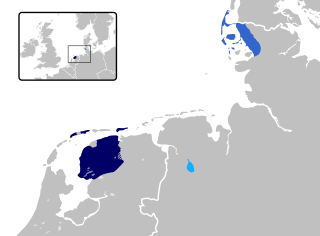
The Frisian languages are a closely related group of West Germanic languages, spoken by about 400,000 Frisian people, who live on the southern fringes of the North Sea in the Netherlands and Germany. The Frisian languages are the closest living language group to the Anglic languages; the two groups make up the Anglo-Frisian languages group and together with the Low German dialects these form the North Sea Germanic languages. However, modern English and Frisian are not mutually intelligible, nor are Frisian languages intelligible among themselves, owing to independent linguistic innovations and foreign influences.
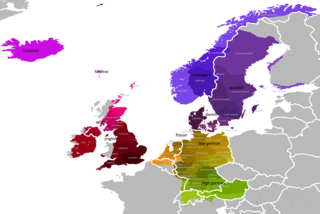
The Germanic languages are a branch of the Indo-European language family spoken natively by a population of about 515 million people mainly in Europe, North America, Oceania and Southern Africa. The most widely spoken Germanic language, English, is also the world's most widely spoken language with an estimated 2 billion speakers. All Germanic languages are derived from Proto-Germanic, spoken in Iron Age Scandinavia and Germany.
Old English, or Anglo-Saxon, is the earliest recorded form of the English language, spoken in England and southern and eastern Scotland in the early Middle Ages. It developed from the languages brought to Great Britain by Anglo-Saxon settlers in the mid-5th century, and the first Old English literary works date from the mid-7th century. After the Norman Conquest of 1066, English was replaced for several centuries by Anglo-Norman as the language of the upper classes. This is regarded as marking the end of the Old English era, since during the subsequent period the English language was heavily influenced by Anglo-Norman, developing into what is now known as Middle English in England and Early Scots in Scotland.

The West Germanic languages constitute the largest of the three branches of the Germanic family of languages. The West Germanic branch is classically subdivided into three branches: Ingvaeonic, which includes English and the Frisian languages; Istvaeonic, which encompasses Dutch and its close relatives; and Irminonic, which includes German and its close relatives and variants.
English is a West Germanic language that originated from Ingvaeonic languages brought to Britain in the mid-5th to 7th centuries AD by Anglo-Saxon migrants from what is now northwest Germany, southern Denmark and the Netherlands. The Anglo-Saxons settled in the British Isles from the mid-5th century and came to dominate the bulk of southern Great Britain. Their language originated as a group of Ingvaeonic languages which were spoken by the settlers in England and southern and eastern Scotland in the early Middle Ages, displacing the Celtic languages that had previously been dominant. Old English reflected the varied origins of the Anglo-Saxon kingdoms established in different parts of Britain. The Late West Saxon dialect eventually became dominant. A significant subsequent influence on the shaping of Old English came from contact with the North Germanic languages spoken by the Scandinavian Vikings who conquered and colonized parts of Britain during the 8th and 9th centuries, which led to much lexical borrowing and grammatical simplification. The Anglian dialects had a greater influence on Middle English.

Low German is a West Germanic language spoken mainly in Northern Germany and the northeastern Netherlands. The dialect of Plautdietsch is also spoken in the Russian Mennonite diaspora worldwide.

West Frisian, or simply Frisian, is a West Germanic language spoken mostly in the province of Friesland in the north of the Netherlands, mostly by those of Frisian ancestry. It is the most widely spoken of the Frisian languages.

Saterland Frisian, also known as Sater Frisian, Saterfrisian or Saterlandic, is the last living dialect of the East Frisian language. It is closely related to the other Frisian languages: North Frisian, spoken in Germany as well, and West Frisian, spoken in the Dutch province of Friesland.
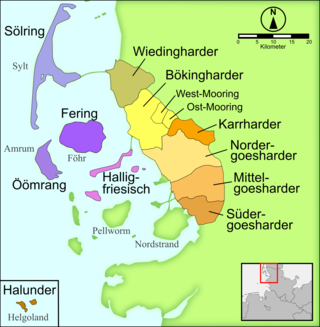
North Frisian is a minority language of Germany, spoken by about 10,000 people in North Frisia. The language is part of the larger group of the West Germanic Frisian languages. The language comprises 10 dialects which are themselves divided into an insular and a mainland group.
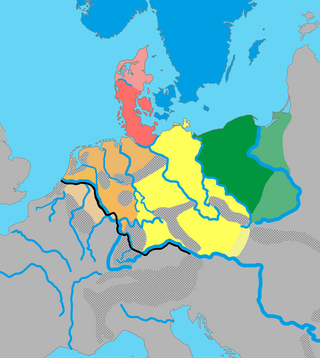
North Sea Germanic, also known as Ingvaeonic, is a postulated grouping of the northern West Germanic languages that consists of Old Frisian, Old English, and Old Saxon, and their descendants.
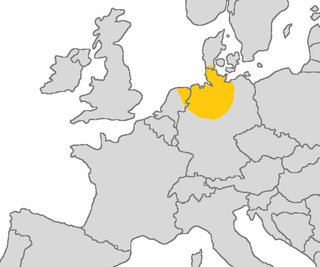
Old Saxon, also known as Old Low German, was a Germanic language and the earliest recorded form of Low German. It is a West Germanic language, closely related to the Anglo-Frisian languages. It is documented from the 8th century until the 12th century, when it gradually evolved into Middle Low German. It was spoken throughout modern northwestern Germany, primarily in the coastal regions and in the eastern Netherlands by Saxons, a Germanic tribe that inhabited the region of Saxony. It partially shares Anglo-Frisian's Ingvaeonic nasal spirant law which sets it apart from Low Franconian and Irminonic languages, such as Dutch, Luxembourgish and German.
Old English phonology is necessarily somewhat speculative since Old English is preserved only as a written language. Nevertheless, there is a very large corpus of the language, and the orthography apparently indicates phonological alternations quite faithfully, so it is not difficult to draw certain conclusions about the nature of Old English phonology.
Like many other languages, English has wide variation in pronunciation, both historically and from dialect to dialect. In general, however, the regional dialects of English share a largely similar phonological system. Among other things, most dialects have vowel reduction in unstressed syllables and a complex set of phonological features that distinguish fortis and lenis consonants.
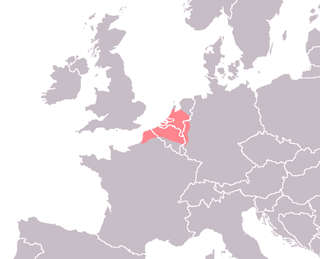
In linguistics, Old Dutch or Old Low Franconian is the set of dialects that evolved from Frankish spoken in the Low Countries during the Early Middle Ages, from around the 6th or 9th to the 12th century. Old Dutch is mostly recorded on fragmentary relics, and words have been reconstructed from Middle Dutch and Old Dutch loanwords in French.

In historical linguistics, the Ingvaeonic nasal spirant law is a description of a phonological development that occurred in the Ingvaeonic dialects of the West Germanic languages. This includes Old English, Old Frisian, and Old Saxon, and to a lesser degree Old Dutch.
The phonology of Old Saxon mirrors that of the other ancient Germanic languages, and also, to a lesser extent, that of modern West Germanic languages such as English, Dutch, Frisian, German, and Low German.
The phonological system of the Old English language underwent many changes during the period of its existence. These included a number of vowel shifts, and the palatalisation of velar consonants in many positions.
The Anglo-Saxon settlement in the Netherlands was a movement of continental Angles, Saxons, Franks and possibly English Anglo-Saxons into the lands formerly inhabited by the ancient Frisii, Cananefates and Batavians. These migrations occurred after the population drop of the Frisii during the 5th century up until the 7th century. These new migrants from northwestern Germany were later referred to as the Frisians by the Merovingian Franks who may have taken this name from older Roman historiography. During these migrations, almost the entire population of the coastal Netherlands was demographically replaced.
References
- 1 2 3 4 Stiles, Patrick (2018-08-01). Friesische Studien II: Beiträge des Föhrer Symposiums zur Friesischen Philologie vom 7.–8. April 1994 (PDF). NOWELE Supplement Series. Vol. 12. doi:10.1075/nss.12. ISBN 978-87-7838-059-3 . Retrieved 2020-10-23– via www.academia.edu.[ dead link ]
- ↑ Hines, John (2017). Frisians and their North Sea Neighbours. Boydell & Brewer. ISBN 978-1-78744-063-0. OCLC 1013723499.
- ↑ Hickey, Raymond (2005). Dublin English: Evolution and Change. John Benjamins Publishing. pp. 196–198. ISBN 90-272-4895-8.
- ↑ Hickey, Raymond (2002). A Source Book for Irish English. John Benjamins Publishing. pp. 28–29. ISBN 9027237530.
- ↑ Hammarström, Harald; Forkel, Robert; Haspelmath, Martin; Bank, Sebastian (2023-07-10). "Glottolog 4.8 - Irish Anglo-Norman". Glottolog . Leipzig, Germany: Max Planck Institute for Evolutionary Anthropology. doi: 10.5281/zenodo.8131084 . Archived from the original on 2023-07-17. Retrieved 2023-07-16.
- ↑ Hammarström, Harald; Forkel, Robert; Haspelmath, Martin, eds. (2017). "Anglic". Glottolog 3.0. Jena, Germany: Max Planck Institute for the Science of Human History.
- ↑ Woolf, Alex (2007). From Pictland to Alba, 789–1070. The New Edinburgh History of Scotland. Edinburgh: Edinburgh University Press. ISBN 978-0-7486-1234-5., p. 336
- ↑ J. Derrick McClure Scots its range of Uses in A. J. Aitken, Tom McArthur, Languages of Scotland, W. and R. Chambers, 1979. p.27
- ↑ Thomas Burns McArthur, The English Languages, Cambridge University Press, 1998. p.203
- 1 2 "Frisian | Ethnologue Free".
- 1 2 "Frisian, Northern | Ethnologue Free".
- ↑ "Saterfriesisch | Ethnologue Free".
- ↑ Fulk, Robert D. (1998). "The Chronology of Anglo-Frisian Sound Changes". In Bremmer Jr., Rolf H.; Johnston, Thomas S.B.; Vries, Oebele (eds.). Approaches to Old Frisian Philology. Amsterdam: Rodopoi. p. 185.
- ↑ Grant, William; Dixon, James Main (1921). Manual of Modern Scots. Cambridge: University Press. p. 105.
- ↑ Some include West Flemish. Cf. Bremmer (2009:22).
- ↑ Munske, Horst Haider; Århammar, Nils, eds. (2001). Handbuch des Friesischen: = Handbook of Frisian studies. Tübingen: Niemeyer. ISBN 978-3-484-73048-9.
- ↑ For a full discussion of the areal changes involved and their relative chronologies, see Voyles (1992).
- ↑ "Friedrich Maurer (Lehrstuhl für Germanische Philologie – Linguistik)". Germanistik.uni-freiburg.de. Retrieved 2013-06-24.
Further reading
- Maurer, Friedrich (1942). Nordgermanen und Alemannen: Studien zur Sprachgeschichte, Stammes- und Volkskunde (in German). Strasbourg: Hünenburg.
- Euler, Wolfram (2013). Das Westgermanische[West Germanic: from its Emergence in the 3rd up until its Dissolution in the 7th Century CE: Analyses and Reconstruction] (in German). London/Berlin: Verlag Inspiration Un Ltd. p. 244. ISBN 978-3-9812110-7-8.
- Ringe, Don; Taylor, Ann (2014). The Development of Old English - A Linguistic History of English. Vol. 2. Oxford: University Press. ISBN 978-0199207848.